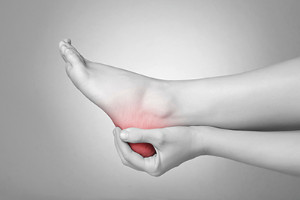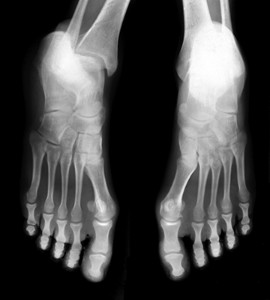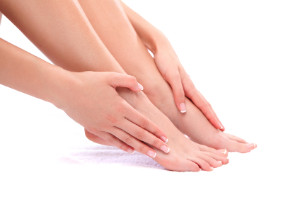





 Heel pain is a condition that plagues many people, and chronic cases can be especially difficult to endure. For many common cases of chronic heel pain, plantar fasciitis is the underlying culprit; plantar fasciitis affects all types of people, though most commonly active men between the ages of 40 and 70. Plantar fasciitis pain manifests in various ways. For some people, it can be described as dull; in other cases, people feel it as a sharp pain, a burning sensation, or an ache that extends outward from the heel. There are various factors that can contribute to plantar fasciitis. To determine the cause of your heel pain and the best way to treat it, consult with your podiatrist.
Heel pain is a condition that plagues many people, and chronic cases can be especially difficult to endure. For many common cases of chronic heel pain, plantar fasciitis is the underlying culprit; plantar fasciitis affects all types of people, though most commonly active men between the ages of 40 and 70. Plantar fasciitis pain manifests in various ways. For some people, it can be described as dull; in other cases, people feel it as a sharp pain, a burning sensation, or an ache that extends outward from the heel. There are various factors that can contribute to plantar fasciitis. To determine the cause of your heel pain and the best way to treat it, consult with your podiatrist.
Many people suffer from bouts of heel pain. For more information, contact one of our podiatrists of Active Foot and Ankle Care, LLC. Our doctors can provide the care you need to keep you pain-free and on your feet.
Causes of Heel Pain
Heel pain is often associated with plantar fasciitis. The plantar fascia is a band of tissues that extends along the bottom of the foot. A rip or tear in this ligament can cause inflammation of the tissue.
Achilles tendonitis is another cause of heel pain. Inflammation of the Achilles tendon will cause pain from fractures and muscle tearing. Lack of flexibility is also another symptom.
Heel spurs are another cause of pain. When the tissues of the plantar fascia undergo a great deal of stress, it can lead to ligament separation from the heel bone, causing heel spurs.
Why Might Heel Pain Occur?
Treatments
Heel pain should be treated as soon as possible for immediate results. Keeping your feet in a stress-free environment will help. If you suffer from Achilles tendonitis or plantar fasciitis, applying ice will reduce the swelling. Stretching before an exercise like running will help the muscles. Using all these tips will help make heel pain a condition of the past.
If you have any questions please contact our offices located in Fair Lawn, Riverdale, and Englewood, NJ . We offer the newest diagnostic and treatment technologies for all your foot and ankle needs.
 Injuries at work are unfortunate events that take place from time to time as a function of working conditions, occupation, and accidents. Causes of severe, acute injuries are usually relatively easy to identify. For example, if someone who uses knives during the course of the work day gets cut, it wouldn’t be too difficult to establish causality. However, for more chronic conditions, like tarsal tunnel syndrome, this may prove to be more difficult. Tarsal tunnel syndrome results when the tibial nerve in the tarsal tunnel is compressed. The symptoms may present themselves as a burning pain in the sole or tingling and numbness at the base of the foot. Repetitive motion of the ankle and the foot may lead to this. As certain occupations require these types of motions, employees may have a greater risk of getting tarsal tunnel syndrome.
Injuries at work are unfortunate events that take place from time to time as a function of working conditions, occupation, and accidents. Causes of severe, acute injuries are usually relatively easy to identify. For example, if someone who uses knives during the course of the work day gets cut, it wouldn’t be too difficult to establish causality. However, for more chronic conditions, like tarsal tunnel syndrome, this may prove to be more difficult. Tarsal tunnel syndrome results when the tibial nerve in the tarsal tunnel is compressed. The symptoms may present themselves as a burning pain in the sole or tingling and numbness at the base of the foot. Repetitive motion of the ankle and the foot may lead to this. As certain occupations require these types of motions, employees may have a greater risk of getting tarsal tunnel syndrome.
Tarsal tunnel syndrome can be very uncomfortable to live with. If you are experiencing tarsal tunnel syndrome, contact one of our podiatrists of Active Foot and Ankle Care, LLC. Our doctors can provide the care you need to keep you pain-free and on your feet.
Tarsal Tunnel Syndrome
Tarsal tunnel syndrome, which can also be called tibial nerve dysfunction, is an uncommon condition of misfiring peripheral nerves in the foot. The tibial nerve is the peripheral nerve in the leg responsible for sensation and movement of the foot and calf muscles. In tarsal tunnel syndrome, the tibial nerve is damaged, causing problems with movement and feeling in the foot of the affected leg.
Common Cause of Tarsal Tunnel Syndrome
The Effects of Tarsal Tunnel Syndrome
A physical exam of the leg can help identify the presence of tarsal tunnel syndrome. Medical tests, such as a nerve biopsy, are also used to diagnose the condition. Patients may receive physical therapy and prescriptive medication. In extreme cases, some may require surgery.
If you have any questions please feel free to contact our offices located in Fair Lawn, Riverdale, and Englewood, NJ . We offer the newest diagnostic and treatment technologies for all your foot and ankle needs.
 Guard T.J. Lang of the Green Bay Packers faced an upset when he reinjured his already broken foot during the NFC Championship Game against the Atlanta Falcons. Following the 44-21 match, which went to Atlanta, many wondered if Lang’s goodbyes would be his last. Next month, the former Packers guard will officially become a free agent. Lang, now 29, hopes he’ll be returning to Green Bay. “I’m just hoping (the NFC Championship Game) wasn’t the last time I get to put on that helmet,” Lang said. “It’s tough, man. Obviously, I’ll take some time, take a couple days, to rest up and recover and see what happens. I think everybody in this locker room knows that this is where I want to be.”
Guard T.J. Lang of the Green Bay Packers faced an upset when he reinjured his already broken foot during the NFC Championship Game against the Atlanta Falcons. Following the 44-21 match, which went to Atlanta, many wondered if Lang’s goodbyes would be his last. Next month, the former Packers guard will officially become a free agent. Lang, now 29, hopes he’ll be returning to Green Bay. “I’m just hoping (the NFC Championship Game) wasn’t the last time I get to put on that helmet,” Lang said. “It’s tough, man. Obviously, I’ll take some time, take a couple days, to rest up and recover and see what happens. I think everybody in this locker room knows that this is where I want to be.”
A broken foot requires immediate medical attention and treatment. If you need your feet checked, contact one of our podiatrists from Active Foot and Ankle Care, LLC. Our doctors can provide the care you need to keep you pain-free and on your feet.
Broken Foot Causes, Symptoms, and Treatment
A broken foot is caused by one of the bones in the foot typically breaking when bended, crushed, or stretched beyond its natural capabilities. Usually the location of the fracture indicates how the break occurred, whether it was through an object, fall, or any other type of injury.
Common Symptoms of Broken Feet:
Those that suspect they have a broken foot shoot seek urgent medical attention where a medical professional could diagnose the severity.
Treatment for broken bones varies depending on the cause, severity and location. Some will require the use of splints, casts or crutches while others could even involve surgery to repair the broken bones. Personal care includes the use of ice and keeping the foot stabilized and elevated.
If you have any questions please feel free to contact our offices located in Fair Lawn, Riverdale, and Englewood, NJ . We offer the newest diagnostic and treatment technologies for all your foot and ankle needs.
 If you’re experiencing pain at the sole of your feet, you may have plantar fasciitis. The words plantar, meaning “the bottom of the foot,” and fasciitis, meaning “inflammation of fascia,” describe the inflammation of our plantar fascia, the tough band of tissue (ligament) lining the bottom of our feet. Plantar fasciitis is one of the most common foot problems seen in patients, caused by factors like continual stress or injury, as the plantar fascia becomes sensitive and can impact everyday movement. Athletes and those who exercise often are most susceptible to plantar fasciitis. Treatments such as cortisone injections, anti-inflammatory medications, therapy, icing, and arch supports can all help treat plantar fasciitis.
If you’re experiencing pain at the sole of your feet, you may have plantar fasciitis. The words plantar, meaning “the bottom of the foot,” and fasciitis, meaning “inflammation of fascia,” describe the inflammation of our plantar fascia, the tough band of tissue (ligament) lining the bottom of our feet. Plantar fasciitis is one of the most common foot problems seen in patients, caused by factors like continual stress or injury, as the plantar fascia becomes sensitive and can impact everyday movement. Athletes and those who exercise often are most susceptible to plantar fasciitis. Treatments such as cortisone injections, anti-inflammatory medications, therapy, icing, and arch supports can all help treat plantar fasciitis.
Plantar fasciitis can be very painful and inconvenient. If you are experiencing heel pain or symptoms of plantar fasciitis, contact one of our podiatrists from Active Foot and Ankle Care, LLC. Our doctors can provide the care you need to keep you pain-free and on your feet.
What Is Plantar Fasciitis?
Plantar fasciitis is the inflammation of the thick band of tissue that runs along the bottom of your foot, known as the plantar fascia, and causes mild to severe heel pain.
What Causes Plantar Fasciitis?
How Can It Be Treated?
While very treatable, plantar fasciitis is definitely not something that should be ignored. Especially in severe cases, speaking to your doctor right away is highly recommended to avoid complications and severe heel pain. Your podiatrist can work with you to provide the appropriate treatment options tailored to your condition.
If you have any questions please feel free to contact our offices located in Fair Lawn, Riverdale, and Englewood, NJ . We offer the newest diagnostic and treatment technologies for all your foot and ankle needs.
Read more about Plantar Fasciitis





